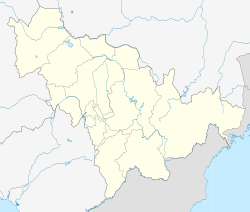| UNESCO World Heritage Site | |
|---|---|
 The Tomb of the General | |
| Location | Liaoning and Jilin in China |
| Includes | |
| Reference | 1135 |
| Inscription | 2004 (28th Session) |
| Area | 4,164.8599 ha (10,291.593 acres) |
| Buffer zone | 14,142.4404 ha (34,946.731 acres) |
| Coordinates | 41°09′25″N 126°11′14″E / 41.15694°N 126.18722°E |
The Capital Cities and Tombs of the Ancient Koguryo Kingdom is an UNESCO World Heritage Site which includes a number of archaeological sites currently in Ji'an, Jilin Province and Huanren, Liaoning Province in Northeast China. Goguryeo (or Koguryo, "Gaogouli" in Chinese), (37 BCE – 668 CE) was a Korean Kingdom[1][2][3][4][5] located in the northern and central parts of the Korean Peninsula and the southern and central parts of Manchuria.
The archaeological sites were collectively designated a cultural World Heritage Site in 2004, qualifying as such under the first five of the six criteria for cultural heritage sites.[6] The designation includes the archaeological remains of three fortress-cities: Wunü Mountain City, Gungnae and Hwando, and forty identified tombs of Goguryeo imperial and noble families.[6]
In 2010, the Chinese government established the Ji'an Gaogouli National Archaeological Park (Chinese: 集安高句丽考古遗址公园), which includes all of the Goguryeo World Heritage Sites in Ji'an and Jilin, but not the ones in Liaoning (such as Wunü Mountain City).[7]
North Korea initially attempted to register the world heritage of the sites from around 2000.[8] Although it was scheduled to be registered in 2003, China opposed the sole registration of North Korea and applied for registration of the Goguryeo ruins scattered in Jilin Province. For this reason, the remains of North Korea and the People's Republic of China were registered in the form of simultaneous registration in 2004. It is recognized that there is an existence of a question on the history of Goguryeo between North Korea and China.
- ^ "Koguryo". Encyclopædia Britannica. Retrieved October 15, 2013.
- ^ Barnes, Gina (2013). State Formation in Korea: Emerging Elites.
- ^ Byington, Mark (2016). The History and Archaeology of the Koguryo Kingdom.
- ^ Li, Narangoa; Cribb, Robert (2014). Historical Atlas of Northeast Asia.
- ^ Gardiner, Kenneth (1964). The origin and rise of the Korean kingdom of Koguryo, from the 1st century to A.D. 313 (PhD). University of London.
- ^ a b "Capital Cities and Tombs of the Ancient Koguryo Kingdom". UNESCO.
- ^ "集安高句丽考古遗址公园(第一批国家考古遗址公园)" (in Chinese). Institute of Archaeology, Chinese Academy of Social Sciences. 28 February 2014.
- ^ "DECISIONS ADOPTED AT THE 28TH SESSION OF THE WORLD HERITAGE COMMITTEE (SUZHOU, 2004)" (PDF). UNESCO. 26 October 2004. p. 29.

